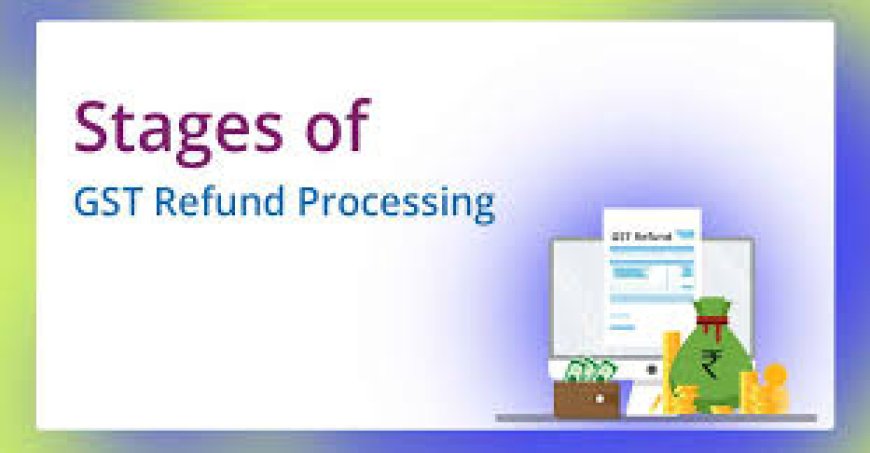What Are the Steps for GST Refund?

The GST Refund Process is a crucial mechanism under India's Goods and Services Tax (GST) system that allows taxpayers to claim back excess taxes paid. Whether it’s due to exports, inverted duty structures, or other scenarios, a smooth refund process is essential to ensure working capital is not locked up unnecessarily. The Indian government has implemented a structured and time-bound procedure to facilitate such claims, thereby improving ease of doing business and enhancing taxpayer confidence.
Understanding how to apply for a GST refund, the different types of refund scenarios, and the eligibility criteria can help individuals and businesses avoid delays and financial hiccups. Let’s take a deeper dive into the steps for GST refund, where to apply, the advantages, and more.
Where Do You Apply for a GST Refund?
GST refund applications are submitted through the official GST portal Registered taxpayers need to log in using their credentials and fill out the appropriate form, usually Form GST RFD-01, to initiate the refund process.
Here is a quick overview of where to apply:
- Online at GST Portal: Login with your GSTIN and password.
- Navigate to Refund Section: Select ‘Services’ > ‘Refunds’ > ‘Application for Refund’.
- Choose the Relevant Category: Based on your case (export, excess payment, etc.)
- Upload Supporting Documents: Submit relevant invoices, bank statements, etc.
- ARN Generation: Application Reference Number is generated for tracking.
The process is entirely digital, making it convenient and transparent for taxpayers across the country.
Advantages of GST Refund
Claiming a GST refund offers numerous benefits, especially for businesses involved in exports or operating under inverted duty structures. Here are some major advantages:
1. Improved Cash Flow
One of the biggest advantages is better cash flow management. A blocked input tax credit or excess payment can significantly affect operations. A timely refund can ease financial pressure.
2. Export Competitiveness
Under GST, exports are considered zero-rated, meaning exporters can claim refunds on the taxes paid on inputs. This improves the cost-efficiency of export-oriented businesses.
3. Encourages Compliance
Knowing that refunds will be processed efficiently encourages businesses to comply with GST rules, file returns on time, and maintain accurate records.
4. Boosts Investor Confidence
A transparent and swift refund mechanism reflects a business-friendly environment, attracting both domestic and foreign investors.
Steps for GST Refund Process
Let’s explore the step-by-step procedure to claim a GST refund:
Step 1: Login to the GST Portal
Visit www.gst.gov.in and log in using your GSTIN (Goods and Services Tax Identification Number) and password.
Step 2: Go to Refund Section
Navigate to Services > Refunds > Application for Refund.
Step 3: Select the Refund Type
Choose the appropriate refund category based on your reason for claiming. Some common options include:
- Excess balance in electronic cash ledger
- Refund of input tax credit on exports
- Inverted duty structure
- Refund on account of supplies made to SEZ
Step 4: Fill Form GST RFD-01
Complete the form with accurate details. You'll need to specify:
- Period for which the refund is being claimed
- Tax paid details
- Invoice details
- Bank account for refund
Step 5: Upload Supporting Documents
Upload required documents, which may include:
- Export invoices
- Bank realization certificates (for exports)
- Statement of invoices
- Declaration under Section 54
Step 6: Submit the Application
Once the form and documents are filled, submit the application. An ARN (Application Reference Number) will be generated for tracking.
Step 7: Acknowledgement and Processing
The refund application is acknowledged in Form GST RFD-02 within 15 days. If additional information is required, the applicant receives a notice in Form GST RFD-03.
Step 8: Provisional Refund (for Exports)
For zero-rated supplies (exports), a 90% provisional refund is granted within 7 days of acknowledgment, subject to certain conditions.
Step 9: Final Order and Refund
The proper officer scrutinizes the application and issues the final order in Form GST RFD-06. If approved, the refund is credited to the applicant’s bank account via Form GST RFD-05.
Step 10: Rejection (if applicable)
If the claim is rejected fully or partially, the applicant is informed via Form GST RFD-08, and they have an opportunity to respond via Form GST RFD-09.
Types of GST Refunds
The GST refund process covers a range of scenarios. Here are the major types:
1. Refund on Exports (Without Payment of Tax)
Businesses exporting goods or services without charging GST can claim a refund on unutilized ITC (Input Tax Credit).
2. Refund on Exports (With Payment of Tax)
In this case, GST is paid on export supplies, and the refund is claimed on the tax paid.
3. Refund Due to Inverted Duty Structure
When the tax rate on inputs is higher than that on outputs, it creates an excess ITC. Businesses can claim a refund for this difference.
4. Refund of Excess Balance in Cash Ledger
If excess funds are lying in the electronic cash ledger, they can be claimed back.
5. Refund on Account of Deemed Exports
Supplies considered as deemed exports are eligible for a refund either to the supplier or recipient.
6. Refund Due to Finalization of Provisional Assessment
If the tax liability is finalized to be lower than provisionally assessed, the difference can be claimed as a refund.
Conclusion
The GST Refund Process is designed to provide relief to taxpayers and ensure that taxes are not unjustly withheld. A clear understanding of the eligibility, documentation, and application procedure is essential for successful and timely refunds.
From export businesses to manufacturers affected by an inverted duty structure, timely refunds can significantly enhance operational efficiency. With the entire process digitized through the GST portal, it has become easier, faster, and more transparent.
Whether you are a small business owner or a large enterprise, following the correct steps for GST refund can prevent your working capital from being locked up and keep your financials healthy.
Frequently Asked Questions
Q1. What is the time limit to apply for a GST refund?
You must apply for a GST refund within 2 years from the relevant date, as per Section 54 of the CGST Act.
Q2. What is the GST RFD-01 form?
GST RFD-01 is the form used to apply for refunds under various scenarios, such as exports, excess cash balance, or inverted duty structure.
Q3. Can I claim a GST refund without a digital signature?
Yes, proprietorships can use an Electronic Verification Code (EVC) instead of a digital signature while filing online.
Q4. How long does it take to receive a GST refund?
Typically, refunds are processed within 60 days of filing. For exporters, 90% of the claim may be granted provisionally within 7 days.
Q5. What happens if the GST refund is rejected?
If the refund is rejected, the applicant is given a notice (RFD-08) and a chance to reply (RFD-09). A revised application or appeal can be filed.
Q6. Are all GST refunds processed online?
Yes, the entire GST refund process is handled through the official GST portal to ensure transparency and efficiency.


































































































































































